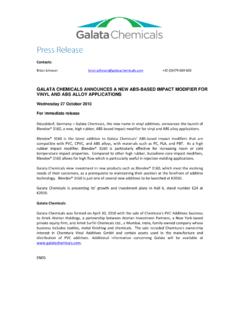Transcription of THE EFFECT OF CALCIUM CARBONATE SIZE AND …
1 2002 ANTEC Conference Proceedings, vol. 3: Special Areas THE EFFECT OF CALCIUM CARBONATE size AND LOADING LEVEL ON THE IMPACT PERFORMANCE OF RIGID PVC COMPOUNDS CONTAINING VARYING AMOUNTS OF ACRYLIC IMPACT MODIFIER William S. Bryant and Henry E. Wiebking Specialty Minerals, Inc. 640 N 13th St. Easton, PA 18042 Abstract This study demonstrates how the impact performance of a rigid polyvinyl chloride (PVC) compound can be affected by the particle size of the CALCIUM CARBONATE filler and its loading level. The test compounds contain 0 to 8phr of acrylic impact modifier and fillers ranging in size from 3 to microns.
2 By taking all three variables into consideration one can, not only optimize a compound s performance, but also lower its cost. Notched Izod and falling weight impact data will be reviewed. Flexural modulus and low temperature impact data are also included. Introduction PVC in its virgin form is virtually unusable from a mechanical property standpoint. Improvement of the mechanical properties of rigid PVC has been under investigation since its discovery in 1927. Because rigid PVC is brittle, additives are needed to increase its impact performance.
3 There are two types of additives used to increase the impact performance of PVC: 1) polymer type impact modifiers (including acrylic, CPE and rubber-like materials), or 2) sub-micron (ultrafine) mineral fillers such as CALCIUM CARBONATE . Factors that EFFECT the impact performance are loading level of the additives and the mineral filler size . We acknowledge that processing conditions also affect the impact properties of the PVC, therefore every effort was made to keep all processing conditions constant for the experimental data presented in this paper.
4 The following graph illustrates the theoretical relationship between impact strength and particle size of CALCIUM CARBONATE (1). As the particle size is decreased below 1 micron there is a significant increase in the impact strength of the material. Ultrafine CALCIUM carbonates (and other minerals) do increase the impact performance of other polymers such as polypropylene (2), polyethylene (3-10), and polyketones (11). Experimental data has confirmed this relationship in our labs (12) and others (13) with PVC. Notched Izod Impact Strength 20 phr CALCIUM CARBONATE filled PVC Particle size (microns)0246810121416182022ft-lbs/in010 020030040050060070080090010001100J/m Coarse CALCIUM carbonates have been used as inexpensive fillers and extenders.
5 The use of ultrafine CALCIUM carbonates as impact modifiers is not a new concept and has been practice for over 20 years (1). These fine products have been used in concert with acrylic impact modifiers or alone. A wide range of loading levels has been used depending on the application and desired mechanical properties. The research reviewed here is intended to help PVC formulators minimize formulation costs. This will be apparent by illustrating the importance of selecting the appropriate CALCIUM CARBONATE size and determining the appropriate loading level of filler and impact modifier.
6 It will be shown that the formulator should let the CALCIUM CARBONATE and impact modifier work together to maximize the impact performance of the PVC compound. Experimental Table 1 contains the PVC formulation used for the experiments. The fillers used had median particle 2sizes ranging between to 3 microns and were either precipitated CALCIUM carbonates (PCCs) or ground CALCIUM carbonates (GCCs).* Table 1. PVC formulation. INGREDIENT DESCRIPTION LOADING LEVEL (phr) Resin Extrusion grade (K=66)
7 100 Stabilizer dibutyltin bis Process aid Acrylic CALCIUM stearate CALCIUM stearate Lube fatty acid ester Lube High-molecular complex ester impact modifier Acrylic 0-8 CALCIUM CARBONATE GCC and PCC 0-20 The test blends were made by first producing a masterbatch, without any impact modifier or filler, and then blending the remaining ingredients to produce the different preblends. The PVC preblends were melt compounded on a Banbury mixer, sheeted off on a two-roll-mill, cooled, granulated, and injection molded into cm thick flex bars and impact disks on an Arburg injection molding machine.
8 An in-the-mold transducer was used to adjust the injection pressure to maintain a constant cavity pressure for all samples. Izod test bars were cut from the molded flex bars and notched using a single tooth carbide cutter. Notched Izod impact tests were run at room temperature (23 oC) on a Tinius Olsen Izod tester. An instrumented falling weight impact tester was used to test the disks. They were clamped onto a support with a cm diameter center hole and impacted by a diameter tip, attached to a kg weight, falling from a height of 20 cm.
9 The test disks were preconditioned in a temperature chamber and removed from the chamber a few seconds before testing. They were tested at 0, -10, and -20 oC. Flexural modulus was measured with an Instron universal tester and three-point bending fixture. Results and Discussion The results of the notched Izod impact tests are shown in graphic form (Figures 1-4) and in Table 2 for several levels of impact modifier, CARBONATE loading level, and particle size . In general, the impact * PCCs used: Ultra-Pflex ( m) = Ultrafine CaCO3, TuffgardTM ( m), Super-Pflex 100 ( m).
10 GCCs used: Superfil ( m), Hi-Pflex 100 ( m). All supplied by Specialty Minerals, Inc. performance of the PVC was improved by increasing the concentration of the sub-micron CALCIUM CARBONATE and impact modifier loading levels. This data demonstrates that a formulation can be developed with a lower level of impact modifier if a suitably sized CALCIUM CARBONATE is used. This allows the formulator to maintain the desired impact resistance and reduce the overall cost of the formulation. Table 2. Notched Izod Impact - J/m (ft-lbs/in) Filler Impact Modifier Level (phr) size (microns) phr 0 2 4 6 10 15 20 134 ( ) 214 ( ) 1505 ( ) 224 ( ) 1543 ( ) 1623 ( ) 1575 ( ) 1601 ( ) 1660 ( ) 1671 ( ) 1639 ( ) 1687 ( ) 10 15 20 144 ( ) 219 ( ) 1671 ( ) 219 ( ) 1665 ( ) 1681 ( ) 1639 ( ) 1676 ( ) 1719 ( ) 1676 ( ) 1697 ( ) 1644 ( ) 10 15 20 144 ( ) 176 ( ) 240 ( ) 181 ( ) 208 ( ) 1639 ( ) 272 ( ) 1665 ( ) 1623 ( ) 1649 ( ) 1665 ( ) 1676 ( ) 2 5 10 15 101 ( ) 112 ( ) 117 ( ) 117 ( ) 133 ( ) 133 ( ) 139 ( ) 149 ( ) 160 ( ) 171 ( ) 166 ( )



